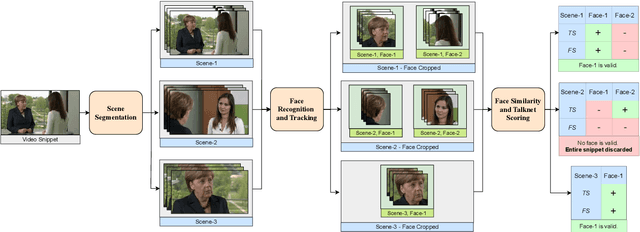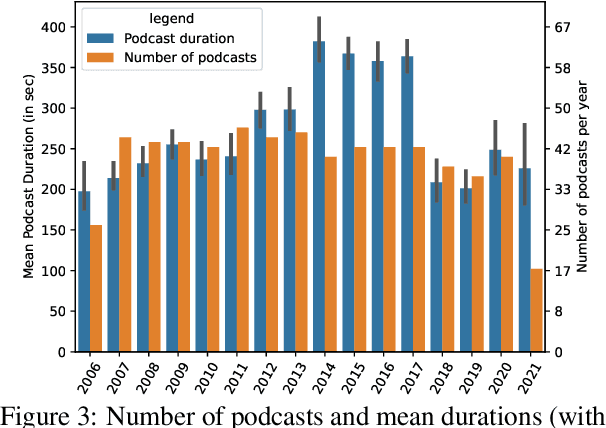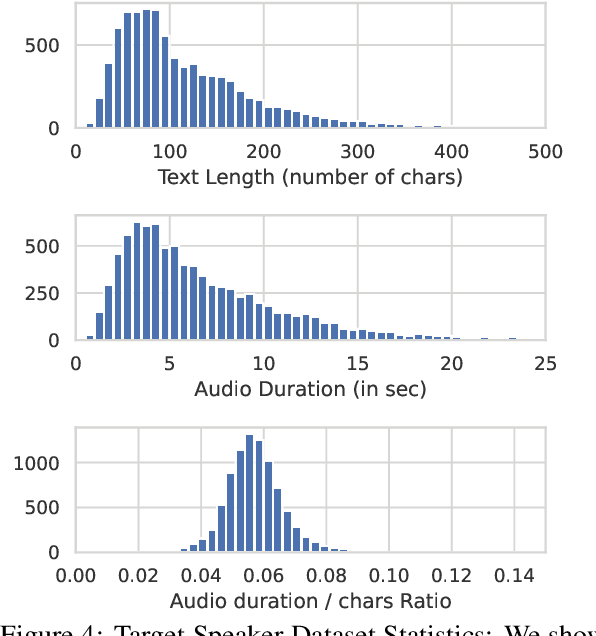Shravan Nayak
CulturalFrames: Assessing Cultural Expectation Alignment in Text-to-Image Models and Evaluation Metrics
Jun 10, 2025Abstract:The increasing ubiquity of text-to-image (T2I) models as tools for visual content generation raises concerns about their ability to accurately represent diverse cultural contexts. In this work, we present the first study to systematically quantify the alignment of T2I models and evaluation metrics with respect to both explicit as well as implicit cultural expectations. To this end, we introduce CulturalFrames, a novel benchmark designed for rigorous human evaluation of cultural representation in visual generations. Spanning 10 countries and 5 socio-cultural domains, CulturalFrames comprises 983 prompts, 3637 corresponding images generated by 4 state-of-the-art T2I models, and over 10k detailed human annotations. We find that T2I models not only fail to meet the more challenging implicit expectations but also the less challenging explicit expectations. Across models and countries, cultural expectations are missed an average of 44% of the time. Among these failures, explicit expectations are missed at a surprisingly high average rate of 68%, while implicit expectation failures are also significant, averaging 49%. Furthermore, we demonstrate that existing T2I evaluation metrics correlate poorly with human judgments of cultural alignment, irrespective of their internal reasoning. Collectively, our findings expose critical gaps, providing actionable directions for developing more culturally informed T2I models and evaluation methodologies.
UI-Vision: A Desktop-centric GUI Benchmark for Visual Perception and Interaction
Mar 19, 2025Abstract:Autonomous agents that navigate Graphical User Interfaces (GUIs) to automate tasks like document editing and file management can greatly enhance computer workflows. While existing research focuses on online settings, desktop environments, critical for many professional and everyday tasks, remain underexplored due to data collection challenges and licensing issues. We introduce UI-Vision, the first comprehensive, license-permissive benchmark for offline, fine-grained evaluation of computer use agents in real-world desktop environments. Unlike online benchmarks, UI-Vision provides: (i) dense, high-quality annotations of human demonstrations, including bounding boxes, UI labels, and action trajectories (clicks, drags, and keyboard inputs) across 83 software applications, and (ii) three fine-to-coarse grained tasks-Element Grounding, Layout Grounding, and Action Prediction-with well-defined metrics to rigorously evaluate agents' performance in desktop environments. Our evaluation reveals critical limitations in state-of-the-art models like UI-TARS-72B, including issues with understanding professional software, spatial reasoning, and complex actions like drag-and-drop. These findings highlight the challenges in developing fully autonomous computer use agents. By releasing UI-Vision as open-source, we aim to advance the development of more capable agents for real-world desktop tasks.
Exploiting Domain-Specific Parallel Data on Multilingual Language Models for Low-resource Language Translation
Dec 27, 2024Abstract:Neural Machine Translation (NMT) systems built on multilingual sequence-to-sequence Language Models (msLMs) fail to deliver expected results when the amount of parallel data for a language, as well as the language's representation in the model are limited. This restricts the capabilities of domain-specific NMT systems for low-resource languages (LRLs). As a solution, parallel data from auxiliary domains can be used either to fine-tune or to further pre-train the msLM. We present an evaluation of the effectiveness of these two techniques in the context of domain-specific LRL-NMT. We also explore the impact of domain divergence on NMT model performance. We recommend several strategies for utilizing auxiliary parallel data in building domain-specific NMT models for LRLs.
BigDocs: An Open and Permissively-Licensed Dataset for Training Multimodal Models on Document and Code Tasks
Dec 05, 2024



Abstract:Multimodal AI has the potential to significantly enhance document-understanding tasks, such as processing receipts, understanding workflows, extracting data from documents, and summarizing reports. Code generation tasks that require long-structured outputs can also be enhanced by multimodality. Despite this, their use in commercial applications is often limited due to limited access to training data and restrictive licensing, which hinders open access. To address these limitations, we introduce BigDocs-7.5M, a high-quality, open-access dataset comprising 7.5 million multimodal documents across 30 tasks. We use an efficient data curation process to ensure our data is high-quality and license-permissive. Our process emphasizes accountability, responsibility, and transparency through filtering rules, traceable metadata, and careful content analysis. Additionally, we introduce BigDocs-Bench, a benchmark suite with 10 novel tasks where we create datasets that reflect real-world use cases involving reasoning over Graphical User Interfaces (GUI) and code generation from images. Our experiments show that training with BigDocs-Bench improves average performance up to 25.8% over closed-source GPT-4o in document reasoning and structured output tasks such as Screenshot2HTML or Image2Latex generation. Finally, human evaluations showed a preference for outputs from models trained on BigDocs over GPT-4o. This suggests that BigDocs can help both academics and the open-source community utilize and improve AI tools to enhance multimodal capabilities and document reasoning. The project is hosted at https://bigdocs.github.io .
Towards Adversarially Robust Vision-Language Models: Insights from Design Choices and Prompt Formatting Techniques
Jul 15, 2024Abstract:Vision-Language Models (VLMs) have witnessed a surge in both research and real-world applications. However, as they are becoming increasingly prevalent, ensuring their robustness against adversarial attacks is paramount. This work systematically investigates the impact of model design choices on the adversarial robustness of VLMs against image-based attacks. Additionally, we introduce novel, cost-effective approaches to enhance robustness through prompt formatting. By rephrasing questions and suggesting potential adversarial perturbations, we demonstrate substantial improvements in model robustness against strong image-based attacks such as Auto-PGD. Our findings provide important guidelines for developing more robust VLMs, particularly for deployment in safety-critical environments.
Benchmarking Vision Language Models for Cultural Understanding
Jul 15, 2024Abstract:Foundation models and vision-language pre-training have notably advanced Vision Language Models (VLMs), enabling multimodal processing of visual and linguistic data. However, their performance has been typically assessed on general scene understanding - recognizing objects, attributes, and actions - rather than cultural comprehension. This study introduces CulturalVQA, a visual question-answering benchmark aimed at assessing VLM's geo-diverse cultural understanding. We curate a collection of 2,378 image-question pairs with 1-5 answers per question representing cultures from 11 countries across 5 continents. The questions probe understanding of various facets of culture such as clothing, food, drinks, rituals, and traditions. Benchmarking VLMs on CulturalVQA, including GPT-4V and Gemini, reveals disparity in their level of cultural understanding across regions, with strong cultural understanding capabilities for North America while significantly lower performance for Africa. We observe disparity in their performance across cultural facets too, with clothing, rituals, and traditions seeing higher performances than food and drink. These disparities help us identify areas where VLMs lack cultural understanding and demonstrate the potential of CulturalVQA as a comprehensive evaluation set for gauging VLM progress in understanding diverse cultures.
Leveraging Auxiliary Domain Parallel Data in Intermediate Task Fine-tuning for Low-resource Translation
Jun 02, 2023Abstract:NMT systems trained on Pre-trained Multilingual Sequence-Sequence (PMSS) models flounder when sufficient amounts of parallel data is not available for fine-tuning. This specifically holds for languages missing/under-represented in these models. The problem gets aggravated when the data comes from different domains. In this paper, we show that intermediate-task fine-tuning (ITFT) of PMSS models is extremely beneficial for domain-specific NMT, especially when target domain data is limited/unavailable and the considered languages are missing or under-represented in the PMSS model. We quantify the domain-specific results variations using a domain-divergence test, and show that ITFT can mitigate the impact of domain divergence to some extent.
Merkel Podcast Corpus: A Multimodal Dataset Compiled from 16 Years of Angela Merkel's Weekly Video Podcasts
May 24, 2022



Abstract:We introduce the Merkel Podcast Corpus, an audio-visual-text corpus in German collected from 16 years of (almost) weekly Internet podcasts of former German chancellor Angela Merkel. To the best of our knowledge, this is the first single speaker corpus in the German language consisting of audio, visual and text modalities of comparable size and temporal extent. We describe the methods used with which we have collected and edited the data which involves downloading the videos, transcripts and other metadata, forced alignment, performing active speaker recognition and face detection to finally curate the single speaker dataset consisting of utterances spoken by Angela Merkel. The proposed pipeline is general and can be used to curate other datasets of similar nature, such as talk show contents. Through various statistical analyses and applications of the dataset in talking face generation and TTS, we show the utility of the dataset. We argue that it is a valuable contribution to the research community, in particular, due to its realistic and challenging material at the boundary between prepared and spontaneous speech.
Pre-Trained Multilingual Sequence-to-Sequence Models: A Hope for Low-Resource Language Translation?
Apr 09, 2022



Abstract:What can pre-trained multilingual sequence-to-sequence models like mBART contribute to translating low-resource languages? We conduct a thorough empirical experiment in 10 languages to ascertain this, considering five factors: (1) the amount of fine-tuning data, (2) the noise in the fine-tuning data, (3) the amount of pre-training data in the model, (4) the impact of domain mismatch, and (5) language typology. In addition to yielding several heuristics, the experiments form a framework for evaluating the data sensitivities of machine translation systems. While mBART is robust to domain differences, its translations for unseen and typologically distant languages remain below 3.0 BLEU. In answer to our title's question, mBART is not a low-resource panacea; we therefore encourage shifting the emphasis from new models to new data.
 Add to Chrome
Add to Chrome Add to Firefox
Add to Firefox Add to Edge
Add to Edge